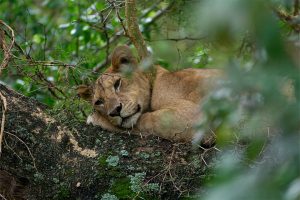A charming little national park with friendly elephants and tree-climbing lions, Lake Manyara is 150 kilometers southeast of the Serengeti. However, it is rather congested with vehicles and has human settlement encroaching on its northern portion. A variety of properties with a good selection of safari, cultural, and active experiences offer guest accommodations.
LOCATION RATING
GUIDE PRICE USD
PER PERSON PER NIGHT
CONSERVATION
RATING

Our Iteneraries are all tailormade to suit your Individual needs and Aspirations.

Lake Manyara, a charming little park situated at the base of the impressive Rift Valley Escarpment, is about 100 kilometers southeast of the Serengeti.
Due to its location alongside the main road that connects Ngorongoro and the Serengeti to the north and Ngorongoro and Arusha to the south, the reserve is very convenient to reach.
Given that the lake occupies two thirds of the park’s area, it contains an unusual variety of habitats and species for an area of its size.
Due to the presence of a groundwater that springs from various locations along the foot of the escarpment, the area is unusually abundant in wildlife year-round.
However, careful planning is undoubtedly required to ensure a quality experience given that the reserve is encroached upon by a sizable town and that there are serious issues with vehicle traffic around the North Gate.
The area is generally regarded as being at its best during the dry season months of June through October, when animals tend to congregate there, but we tend to include it more during seasons with lower vehicle traffic, namely March through May and November through December.
The best lodges can be found either inside the national park or in the nearby private reserves.
Given that the lake itself occupies two thirds of the 330 square kilometer conservation area, Lake Manyara has an unusual variety of habitats and species for such a small conservation area.
The sizable groundwater forest located directly beneath the viewpoint at the park’s northernmost point is arguably its most significant feature. This lush forest is supported by a number of springs that are fed by water that is forced upward along the Rift Valley fault. This water is reasonably consistent throughout the year, and the forest serves as a haven for local wildlife during the protracted dry season, drawing in a wider variety of migratory animals, especially elephants.
Large tracts of dry acacia forest can be found further south, surrounded by wide-open grasslands that open up to the lake’s mudflats.
The size of Lake Manyara itself varies greatly from season to season and year to year depending on the amount of precipitation and the rate of evaporation. It can sometimes resemble a sizable inland sea, while other times it may only be seen as a very large muddy puddle.
An unusually wide variety of mammal sightings can typically be found during a quick drive around Lake Manyara National Park.
This may be one of the best places in the area to see elephants during the dry season of June to November. The elephants that live in the groundwater forest are frequently very accustomed to seeing cars. On one occasion, a towering bull entered the roof hatch of our Land Rover, sniffed around in our hair for something to eat, then rubbed his rear end against our bull-bars and strolled away, forcing us to sit very still and hold our breath.
Although the park is well-known for its tree-climbing lions, in reality, they are not particularly prone to this behavior anywhere—it occurs frequently wherever biting flies are an issue.
We particularly enjoy observing the baboon troops that live in the groundwater forest because they are accustomed to seeing cars. In fact, we believe that viewing baboons up close is one of the most underrated experiences and that this is among the easiest places we are aware of to do so.
Additionally, watch out for dik-diks, tiny antelopes with peculiarly curved noses. They are frequently spotted on the escarpment’s lower slopes.
It is frequently possible to get good wildlife sightings on the open grassland areas surrounding the lake, including giraffes, zebras, wildebeest, and buffaloes.
With nearly 400 species recorded, Lake Manyara is regarded as one of Tanzania’s best places for bird watching.
Even though they don’t appear to breed here, it has been estimated that as many as a million lesser flamingos occasionally congregate on the lake.
The lake is also populated seasonally by large numbers of white pelicans, pink-backed pelicans, greater flamingos, and yellow-billed storks.
Numerous other waterfowl, including many migrant birds from Euraasia, also prefer the lakeshore.
African fish eagles, Ruppell’s griffon vultures, Egyptian vultures, palmnut vultures, Verreaux’s eagles, crowned eagles, martial eagles, bat hawks, and peregrine falcons are just a few of the impressive 46 species of birds of prey that make up this group.
Evergreen forests are home to vocal silvery hornbills, while family groups of southern ground hornbills prowl the open woodlands.
Fischer’s lovebirds, blue-naped mousebirds, grey-headed kingfishers, Abyssinian scimitarbills, red-and-yellow barbets, and Peters twinspots are a few of the more colorful bush birds.
Ashy starlings, slender-tailed nightjars, Abyssinian white-eyes, Pangani longclaws, eastern nicators, and long-tailed fiscals are some of the other more specialized highlights.
We have prepared sample Iteneraries for your Safaris. All Iteneraries can be customized to your preferences
We’ll plan your trip around your specific interests, tastes and preferences, providing helpful tips and honest advice based on first-hand knowledge of the destination.
Our Adventures are designed with responsible travel principles that prioritise travel experiences that are both good for you and good for the planet.
We’ll plan your trip around your specific interests, tastes and preferences, providing helpful tips and honest advice based on first-hand knowledge of the destination.
